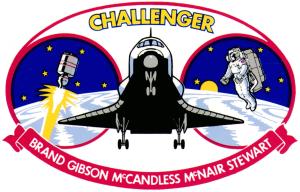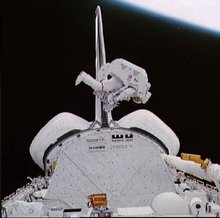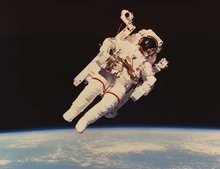STS-41-B
|
|
| Mission Insignia | |
|---|---|
 | |
| Mission Statistics | |
| Mission: | STS 41-B |
| Shuttle: | Challenger |
| Launch Pad: | 39-A |
| Launch: | February 3, 1984, 8:00:00 a.m. EST |
| Landing: | February 11, 1984, 7:15:55 a.m. EST, Kennedy Space Center |
| Duration: | 7/23:15:55 |
| Orbit Altitude: | 189 nautical miles |
| Orbit Inclination: | 28.5 degrees |
| Miles Traveled: | 3,311,380 |
| Crew Photo | |
| Missing image STS-41-B_crew.jpg image:STS-41-B crew.jpg Seated from left to right are Vance Brand, crew commander, and Robert "Hoot" Gibson, pilot. Both men are wearing shuttle blue flight suits. Standing from left to right are mission specialists Robert L. Stewart, Ronald McNair and Bruce McCandless. Both Stewart and McCandless are wearing extravehicular mobility units (EMU). | |
STS 41-B was the tenth flight of a Space Shuttle and the fourth for Challenger. The mission featured the first untethered spacewalks and executed the first landing at Kennedy Space Center.
| Contents |
Crew
- Vance Brand (flew on Apollo-Soyuz, STS-5, STS-41-B & STS-35), Commander
- Robert L. Gibson (flew on STS-41-B, STS-61-C, STS-27, STS-47 & STS-71), Pilot
- Bruce McCandless II (flew on STS-41-B & STS-31), Mission Specialist
- Ronald E. McNair (flew on STS-41-B & STS-51-L), Mission Specialist
- Robert L. Stewart (flew on STS-41-B & STS-51-J), Mission Specialist
Mission Parameters
- Mass:
- Orbiter Liftoff: 113,527 kg
- Orbiter Landing: 91,278 kg
- Payload: 15,362 kg
- Perigee: 307 km
- Apogee: 316 km
- Inclination: 28.5°
- Period: 90.8 min
Space walks
- McCandless and Stewart - EVA 1
- EVA 1 Start: February 7, 1984
- EVA 1 End: February 7, 1984
- Duration: 5 hours, 55 minutes
- McCandless and Stewart - EVA 2
- EVA 2 Start: February 9, 1984
- EVA 2 End: February 9, 1984
- Duration: 6 hours, 17 minutes
Mission Highlights
Following STS-9, the flight numbering system for Space Shuttle missions was changed. Thus, the next flight, instead of being designated STS-10, became STS 41-B. The new numbering system was designed to be more specific in that the first numeral stood for the fiscal year in which the launch was to take place, the "4" being 1984. The second numeral represented the launch site l for KSC and 2 for Vandenberg AFB, Calif. The letter represented the order of launch assignment, " B" was the second launch scheduled in that fiscal year. (Following the Challenger accident, NASA reestablished the original numerical numbering system. Thus the first flight following 51-L is STS-26.)
The mission was the fourth flight of the Challenger. Liftoff occurred at 8 a.m. EST, on Feb. 3, 1984. Two communications satellites were one for Western Union (WESTAR) and the other for Indonesia (Palapa B-2) were deployed about 8 hours after launch. However, the Payload Assist Modules (PAM) for both satellites malfunctioned placing them into a lower than planned orbit. Both satellites were retrieved successfully the following November during STS 51-A, the 14th mission, by the orbiter Discovery.
The STS 41-B crew included commander Vance D. Brand, making his second Shuttle flight; pilot Robert L. Gibson; and mission specialists, Bruce McCandless II, Ronald E. McNair and Robert L. Stewart.
A highlight of the mission took place on the first day when astronauts McCandless and Stewart performed the first untethered space walk operating the Manned Maneuvering Unit (MMU) for the first time. McCandless -- the first human Earth-orbiting satellite -- ventured out 320 feet from the orbiter, while Stewart tested the "work station" foot restraint at the end of the Remote Manipulator System. The seventh day of the mission, both astronauts performed an EVA to practice capture procedures for the Solar Maximum Mission satellite retrieval and repair operation planned for the next mission, STS 41-C.
Another important "first" for STS 41-B was the reflight of the West German-sponsored SPAS-l pallet/satellite originally flown on STS-7. This time, however, it remained in the payload bay because of an electrical problem in the RMS. The mission also carried five GAS canisters, six live rats in the middeck area, a Cinema-360 camera and continuation of the Continuous Flow Electrophoresis System and the Monodisperse Latex Reactor experiments.
The 7-day, 23-hour, 15-minute, 55-second flight ended on Feb. ll, at 7:15 a.m. EST; at KSC's Shuttle Landing Facility -- the first landing of a spacecraft at its launch site. Challenger completed 127 orbits and traveled 2.8 million miles.
This flight marked the first untethered space walks by McCandless and Stewart, using the manned maneuvering unit. WESTAR-VI and PALAPA-B2 satellites deployed, unsuccessfully because the Payload Assist Module-D (PAM-D) rocket motors failed, leaving them in radical low-Earth orbits. The German-built Shuttle Pallet Satellite (SPAS), first flown on STS-7, became the first satellite to be refurbished and flown again. SPAS remained in the payload bay since there was an electrical problem with the Remote Manipulator System (RMS). This flight marked the first use of the RMS manipulator foot restraint and offered astronauts an opportunity to practice procedures for the Solar Maximum satellite retrieval and repair conducted on STS-41-C. An internal failure scrubbed the Integrated Rendezvous Target (IRT) exercise. Five Get Away Special canisters flew in the cargo bay and the crew used a Cinema-360 camera to document their flight. Other payloads: Acoustic Containerless Experiment System (ACES); Monodisperse Latex Reactor (MLR); and Radiation Monitoring Equipment (RME), and Isoelectric Focusing (IEF) payload.
 Astronaut Bruce McCandless exercises the Manned Maneuvering Unit. (NASA) |
Related articles
- Space science
- Space shuttle
- List of space shuttle missions
- List of human spaceflights chronologically
External links
- NASA mission description (http://science.ksc.nasa.gov/shuttle/missions/41-b/mission-41-b.html)
- Additional information (http://science.ksc.nasa.gov/shuttle/missions/41-b/41-b-info.html)
| Previous Mission: STS-9 |
Space Shuttle program | Next Mission: STS-41-C |

